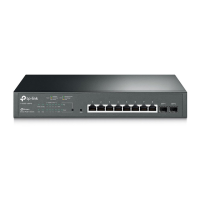JetStream 52-Port Gigabit Stackable L3 Managed Switch CLI Guide
Chapter 11 Etherchannel Commands
Etherchannel Commands are used to configure LAG and LACP function.
LAG (Link Aggregation Group) is to combine a number of ports together to make a single
high-bandwidth data path, which can highly extend the bandwidth. The bandwidth of the LAG is
the sum of bandwidth of its member port.
LACP (Link Aggregation Control Protocol) is defined in IEEE802.3ad and enables the dynamic
link aggregation and disaggregation by exchanging LACP packets with its partner. The switch
can dynamically group similarly configured ports into a single logical link, which will highly
extend the bandwidth and flexibly balance the load.
11.1 channel-group
Description
The channel-group command is used to add a port to the EtherChannel
Group and configure its mode. To delete the port from the EtherChannel
Group, please use no channel-group command.
Syntax
channel-group
num
mode { on | active | passive }
no channel-group
Parameter
num
—— The number of the EtherChannel Group, ranging from 1 to 64.
on —— Enable the static LAG.
active —— Enable the active LACP mode.
passive —— Enable the passive LACP mode.
Command Mode
Interface Configuration Mode (interface fastEthernet / interface range
fastEthernet / interface gigabitEthernet / interface range gigabitEthernet/
interface ten-gigabitEthernet / interface range ten-gigabitEthernet)
Example
Add the Gigabit Ethernet port 2-4 to EtherChannel Group 1 and enable the
static LAG:
61

